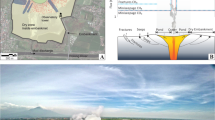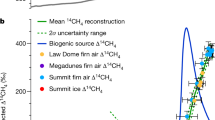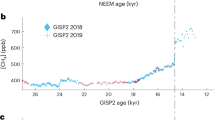Abstract
Methane (CH4) is a powerful greenhouse gas and plays a key part in global atmospheric chemistry. Natural geological emissions (fossil methane vented naturally from marine and terrestrial seeps and mud volcanoes) are thought to contribute around 52 teragrams of methane per year to the global methane source, about 10 per cent of the total, but both bottom-up methods (measuring emissions)1 and top-down approaches (measuring atmospheric mole fractions and isotopes)2 for constraining these geological emissions have been associated with large uncertainties. Here we use ice core measurements to quantify the absolute amount of radiocarbon-containing methane (14CH4) in the past atmosphere and show that geological methane emissions were no higher than 15.4 teragrams per year (95 per cent confidence), averaged over the abrupt warming event that occurred between the Younger Dryas and Preboreal intervals, approximately 11,600 years ago. Assuming that past geological methane emissions were no lower than today3,4, our results indicate that current estimates of today’s natural geological methane emissions (about 52 teragrams per year)1,2 are too high and, by extension, that current estimates of anthropogenic fossil methane emissions2 are too low. Our results also improve on and confirm earlier findings5,6,7 that the rapid increase of about 50 per cent in mole fraction of atmospheric methane at the Younger Dryas–Preboreal event was driven by contemporaneous methane from sources such as wetlands; our findings constrain the contribution from old carbon reservoirs (marine methane hydrates8, permafrost9 and methane trapped under ice10) to 19 per cent or less (95 per cent confidence). To the extent that the characteristics of the most recent deglaciation and the Younger Dryas–Preboreal warming are comparable to those of the current anthropogenic warming, our measurements suggest that large future atmospheric releases of methane from old carbon sources are unlikely to occur.
This is a preview of subscription content, access via your institution
Access options
Access Nature and 54 other Nature Portfolio journals
Get Nature+, our best-value online-access subscription
$29.99 / 30 days
cancel any time
Subscribe to this journal
Receive 51 print issues and online access
$199.00 per year
only $3.90 per issue
Buy this article
- Purchase on Springer Link
- Instant access to full article PDF
Prices may be subject to local taxes which are calculated during checkout

Similar content being viewed by others
References
Etiope, G., Lassey, K. R., Klusman, R. W. & Boschi, E. Reappraisal of the fossil methane budget and related emission from geologic sources. Geophys. Res. Lett. 35, L09307 (2008)
Schwietzke, S. et al. Upward revision of global fossil fuel methane emissions based on isotope database. Nature 538, 88–91 (2016)
Etiope, G., Milkov, A. V. & Derbyshire, E. Did geologic emissions of methane play any role in Quaternary climate change? Global Planet. Change 61, 79–88 (2008)
Luyendyk, B., Kennett, J. & Clark, J. F. Hypothesis for increased atmospheric methane input from hydrocarbon seeps on exposed continental shelves during glacial low sea level. Mar. Pet. Geol. 22, 591–596 (2005)
Petrenko, V. V. et al. 14CH4 measurements in Greenland ice: investigating last glacial termination CH4 sources. Science 324, 506–508 (2009)
Schaefer, H. et al. Ice record of δ13C for atmospheric CH4 across the Younger Dryas–Preboreal transition. Science 313, 1109–1112 (2006)
Sowers, T. Late quaternary atmospheric CH4 isotope record suggests marine clathrates are stable. Science 311, 838–840 (2006)
Kennett, J. P., Cannariato, K. G., Hendy, I. L. & Behl, R. J. Methane Hydrates in Quaternary Climate Change: The Clathrate Gun Hypothesis (AGU, 2003)
Walter, K. M., Edwards, M. E., Grosse, G., Zimov, S. A. & Chapin, F. S. III . Thermokarst lakes as a source of atmospheric CH4 during the last deglaciation. Science 318, 633–636 (2007)
Weitemeyer, K. A. & Buffett, B. A. Accumulation and release of methane from clathrates below the Laurentide and Cordilleran ice sheets. Global Planet. Change 53, 176–187 (2006)
Kirschke, S. et al. Three decades of global methane sources and sinks. Nat. Geosci. 6, 813–823 (2013)
Lassey, K. R., Lowe, D. C. & Smith, A. M. The atmospheric cycling of radiomethane and the ‘fossil fraction’ of the methane source. Atmos. Chem. Phys. 7, 2141–2149 (2007)
Wahlen, M. et al. Carbon-14 in methane sources and in atmospheric methane—the contribution from fossil carbon. Science 245, 286–290 (1989)
Winckler, G. et al. Noble gases and radiocarbon in natural gas hydrates. Geophys. Res. Lett. 29, 63-1–63-4 (2002)
Walter, K. M., Chanton, J. P., Chapin, F. S., Schuur, E. A. G. & Zimov, S. A. Methane production and bubble emissions from arctic lakes: isotopic implications for source pathways and ages. J. Geophys. Res. 113, G00A08 (2008)
Petrenko, V. V. et al. Measurements of 14C in ancient ice from Taylor Glacier, Antarctica constrain in situ cosmogenic 14CH4 and 14CO production rates. Geochim. Cosmochim. Acta 177, 62–77 (2016)
Petrenko, V. V. et al. High-precision 14C measurements demonstrate production of in situ cosmogenic 14CH4 and rapid loss of in situ cosmogenic 14CO in shallow Greenland firn. Earth Planet. Sci. Lett. 365, 190–197 (2013)
Buizert, C. et al. Radiometric 81Kr dating identifies 120,000-year-old ice at Taylor Glacier, Antarctica. Proc. Natl Acad. Sci. USA 111, 6876–6881 (2014)
Reimer, P. J. et al. Intcal13 and Marine13 radiocarbon age calibration curves 0–50,000 years cal bp. Radiocarbon 55, 1869–1887 (2013)
Chappellaz, J. et al. Synchronous changes in atmospheric CH4 and Greenland climate between 40 and 8 kyr bp. Nature 366, 443–445 (1993)
Archer, D., Buffett, B. & Brovkin, V. Ocean methane hydrates as a slow tipping point in the global carbon cycle. Proc. Natl Acad. Sci. USA 106, 20596–20601 (2009)
O’Connor, F. M. et al. Possible role of wetlands, permafrost, and methane hydrates in the methane cycle under future climate change: a review. Rev. Geophys. 48, RG4005 (2010)
Wadham, J. L. et al. Potential methane reservoirs beneath Antarctica. Nature 488, 633–637 (2012)
Walter, K. M ., Smith, L. C . & Chapin, F. S. Methane bubbling from northern lakes: present and future contributions to the global methane budget. Phil. Trans. R. Soc. A 365, 1657–1676 (2007)
Fischer, H. et al. Changing boreal methane sources and constant biomass burning during the last termination. Nature 452, 864–867 (2008)
Möller, L. et al. Independent variations of CH4 emissions and isotopic composition over the past 160,000 years. Nat. Geosci. 6, 885–890 (2013)
Walter Anthony, K. M., Anthony, P., Grosse, G. & Chanton, J. Geologic methane seeps along boundaries of Arctic permafrost thaw and melting glaciers. Nat. Geosci. 5, 419–426 (2012)
Clark, P. U. et al. Global climate evolution during the last deglaciation. Proc. Natl Acad. Sci. USA 109, E1134–E1142 (2012)
Schaefer, H. et al. A 21st-century shift from fossil-fuel to biogenic methane emissions indicated by 13CH4 . Science 352, 80–84 (2016)
Marcott, S. A. et al. Centennial-scale changes in the global carbon cycle during the last deglaciation. Nature 514, 616–619 (2014)
Buizert, C. et al. The WAIS Divide deep ice core WD2014 chronology—Part 1: Methane synchronization (68–31 ka bp) and the gas age–ice age difference. Clim. Past 11, 153–173 (2015)
Schilt, A. et al. Atmospheric nitrous oxide during the last 140,000 years. Earth Planet. Sci. Lett. 300, 33–43 (2010)
Stuiver, M. & Polach, H. A. Discussion: reporting of 14C data. Radiocarbon 19, 355–363 (1977)
Acknowledgements
This work was supported by US National Science Foundation Awards 0839031 (J.P.S.), 0838936 (E.B.) and 1245659 (V.V.P.), the National Oceanic and Atmospheric Administration Climate and Global Change Postdoctoral Fellowship (C.B.), the Packard Fellowship for Science and Engineering (V.V.P.), the Marsden Fund Council from New Zealand Government funding administered by the Royal Society of New Zealand (H.S.) and the ANSTO Isotopes in Climate Change and Atmospheric Systems project (A.M.S.). Further support came from NIWA under Climate and Atmosphere Research Programme CAAC1504 (2014/15 SCI). We acknowledge the financial support from the Australian Government for the Centre for Accelerator Science at ANSTO through the National Collaborative Research Infrastructure Strategy. We thank the US Antarctic Program for field support, US Ice Drilling and Development Office for ice drilling support, R. Beaudette for logistical assistance, the Institut Polaire Français Paul-Emile Victor for supporting X.F.’s field participation, J. Shakun for providing deglacial ice volume and temperature data, and M. Dyonisius, H. Graven, J. Miller, E. Dlugokencky, L. Murray, T. Weber, B. Hmiel and S. Schwietzke for comments.
Author information
Authors and Affiliations
Contributions
V.V.P., J.P.S. and E.B. designed the study. V.V.P., J.P.S., D.B., T.B. and E.B. conducted field logistical preparations. V.V.P. led the Antarctic field campaign, with D.B., H.S., C.B., A.S., X.F., L.M. and T.B. participating in sampling and field [CH4] analyses. E.B. supervised analyses of [CH4] in small ice samples in his laboratory. C.H. analysed [CH4] and halocarbons in large air samples under the supervision of R.F.W. D.B. performed analyses of δ15N, δXe/N2 and δKr/N2 with assistance from A.O. K.R. measured [CO] and δ13CH4, and performed the extractions of CH4 and CO from sample air, with assistance from H.S. A.M.S. and Q.H. carried out graphitization and accelerator mass spectrometry 14C analyses. H.S. did the Monte Carlo calculations of CH4 emissions. V.V.P. performed the data corrections and analyses, determined sample ages and wrote the manuscript, with assistance from all other authors.
Corresponding author
Ethics declarations
Competing interests
The authors declare no competing financial interests.
Additional information
Reviewer Information Nature thanks P. Hopcroft, R. Muscheler and the other anonymous reviewer(s) for their contribution to the peer review of this work.
Publisher's note: Springer Nature remains neutral with regard to jurisdictional claims in published maps and institutional affiliations.
Supplementary information
Supplementary Information
This file contains Supplementary Methods (sections 1-6) and Supplementary Discussion (sections 7-10), Supplementary Figures 1-11, Supplementary Tables 1-11 and additional references. (PDF 7101 kb)
PowerPoint slides
Rights and permissions
About this article
Cite this article
Petrenko, V., Smith, A., Schaefer, H. et al. Minimal geological methane emissions during the Younger Dryas–Preboreal abrupt warming event. Nature 548, 443–446 (2017). https://doi.org/10.1038/nature23316
Received:
Accepted:
Published:
Issue Date:
DOI: https://doi.org/10.1038/nature23316
This article is cited by
-
Methane emissions decreased in fossil fuel exploitation and sustainably increased in microbial source sectors during 1990–2020
Communications Earth & Environment (2024)
-
Atmospheric methane variability through the Last Glacial Maximum and deglaciation mainly controlled by tropical sources
Nature Geoscience (2023)
-
Panarctic lakes exerted a small positive feedback on early Holocene warming due to deglacial release of methane
Communications Earth & Environment (2023)
-
Past permafrost dynamics can inform future permafrost carbon-climate feedbacks
Communications Earth & Environment (2023)
-
Early Holocene permafrost retreat in West Siberia amplified by reorganization of westerly wind systems
Communications Earth & Environment (2021)
Comments
By submitting a comment you agree to abide by our Terms and Community Guidelines. If you find something abusive or that does not comply with our terms or guidelines please flag it as inappropriate.



